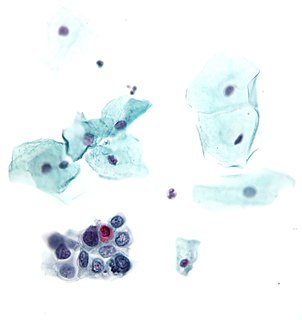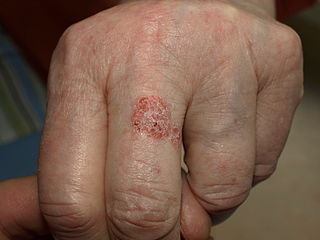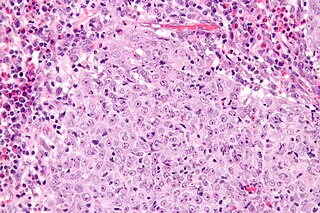
The Papanicolaou test is a method of cervical screening used to detect potentially precancerous and cancerous processes in the cervix. Abnormal findings are often followed up by more sensitive diagnostic procedures and if warranted, interventions that aim to prevent progression to cervical cancer. The test was independently invented by Dr. Georgios Papanikolaou and Dr. Aurel Babeș and named after Papanikolaou.

Cervical cancer is a cancer arising from the cervix. It is due to the abnormal growth of cells that have the ability to invade or spread to other parts of the body. Early on, typically no symptoms are seen. Later symptoms may include abnormal vaginal bleeding, pelvic pain or pain during sexual intercourse. While bleeding after sex may not be serious, it may also indicate the presence of cervical cancer.

Bowen's disease, also known as squamous cell carcinoma in situ is a neoplastic skin disease. It can be considered as an early stage or intraepidermal form of squamous cell carcinoma. It was named after John T. Bowen.

Cytopathology is a branch of pathology that studies and diagnoses diseases on the cellular level. The discipline was founded by George Nicolas Papanicolaou in 1928. Cytopathology is generally used on samples of free cells or tissue fragments, in contrast to histopathology, which studies whole tissues.

Colposcopy is a medical diagnostic procedure to examine an illuminated, magnified view of the cervix as well as the vagina and vulva. Many pre-malignant lesions and malignant lesions in these areas have discernible characteristics that can be detected through the examination. It is done using a colposcope, which provides an magnified view of the areas, allowing the colposcopist to visually distinguish normal from abnormal appearing tissue and take directed biopsies for further pathological examination. The main goal of colposcopy is to prevent cervical cancer by detecting and treating precancerous lesions early. The procedure was developed by the German physician Hans Hinselmann, with help from Eduard Wirths. The development of colposcopy involved experimentation on Jewish inmates from Auschwitz.

Anal cancer is a cancer which arises from the anus, the distal opening of the gastrointestinal tract. Symptoms may include bleeding from the anus or a lump near the anus. Other symptoms may include pain, itchiness, or discharge from the anus. A change in bowel movements may also occur.
The loop electrosurgical excision procedure (LEEP) is one of the most commonly used approaches to treat high grade cervical dysplasia discovered on colposcopic examination. In the UK, it is known as large loop excision of the transformation zone (LLETZ).

Carcinoma in situ (CIS) is a group of abnormal cells. While they are a form of neoplasm, there is disagreement over whether CIS should be classified as cancer. This controversy also depends on the exact CIS in question. Some authors do not classify them as cancer, however, recognizing that they can potentially become cancer. Others classify certain types as a non-invasive form of cancer. The term "pre-cancer" has also been used.

A precancerous condition is a condition or lesion involving abnormal cells which are associated with an increased risk of developing into cancer. Clinically, precancerous conditions encompass a variety of conditions or lesions with an increased risk of developing into cancer. Some of the most common precancerous conditions include certain colon polyps, which can progress into colon cancer, monoclonal gammopathy of undetermined significance, which can progress into multiple myeloma or myelodysplastic syndrome. and cervical dysplasia, which can progress into cervical cancer. Pathologically, precancerous lesions can range from benign neoplasias, which are tumors which do not invade neighboring normal tissues or spread to distant organs, to dysplasia, which involves collections of abnormal cells which in some cases have an increased risk of progressing to anaplasia and invasive cancer. Sometimes the term "precancer" is also used for carcinoma in situ, which is a noninvasive cancer that has not progressed to an aggressive, invasive stage. As with other precancerous conditions, not all carcinoma in situ will progress to invasive disease.

Cervical cerclage, also known as a cervical stitch, is a treatment for cervical incompetence or insufficiency, when the cervix starts to shorten and open too early during a pregnancy causing either a late miscarriage or preterm birth. Usually the treatment is done in the first or second trimester of pregnancy, for a woman who has had one or more late miscarriages in the past. The word "cerclage" means "hoop" in French, as in the metal hoop encircling a barrel.
Cervical stenosis means that the opening in the cervix is more narrow than is typical. In some cases, the endocervical canal may be completely closed. A stenosis is any passage in the body that is more narrow than it should typically be.
The Bethesda system (TBS) is a system for reporting cervical or vaginal cytologic diagnoses, used for reporting Pap smear results. It was introduced in 1988 and revised in 1991, 2001, and 2014. The name comes from the location of the conference that established the system.
Speculoscopy is a procedure in which a special blue-white light (Speculite) is used to examine the cervix for cancerous or pre-cancerous lesions.

Glassy cell carcinoma of the cervix, also glassy cell carcinoma, is a rare aggressive malignant tumour of the uterine cervix. The tumour gets its name from its microscopic appearance; its cytoplasm has a glass-like appearance.

Villoglandular adenocarcinoma of the cervix is a rare type of cervical cancer that, in relation to other cervical cancers, is typically found in younger women and has a better prognosis.
Vinegar test is a cervical cancer testing method that uses acetic acid, a major component of vinegar. It has been found to be useful as an effective and inexpensive screening test. It has the potential, say researchers from the University of Zimbabwe and Johns Hopkins University, to improve the chances of preventing cancer in developing world. The technique, termed VIA /Cryo, was endorsed by the World Health Organization in 2010. Vinegar is brushed on a woman’s cervix and precancerous spots turn white. These can be instantly frozen off with a metallic probe cooled with dry ice. Vinegar highlights tumors, which have more DNA, and therefore less water and more protein, than healthy tissue. As of 2011, Thailand has adopted the technique in twenty-nine of its (then) seventy-five provinces, and 500,000 women have been tested at least once.
A well woman examination is an exam offered to women to review elements of their reproductive health. It is recommended once a year for most women. The exam includes a breast examination, a pelvic examination and a pap smear but may also include other procedures. Hospitals employ strict policies relating to the provision of consent by the patient, the availability of chaperones at the examination, and the absence of other parties.
Postcoital bleeding is bleeding from the vagina in women after sexual intercourse and may or may not be associated with pain. The bleeding can be from the uterus, cervix, vagina and other tissue or organs located near the vagina. Postcoital bleeding can be one of the first indications of cervical cancer. There are other reasons why a woman may bleed after intercourse. Some women will bleed after intercourse for the first time but others will not. The hymen may bleed if it is stretched since it is thin tissue. Other activities may have an effect on the vagina such as sports and tampon use. Postcoital bleeding may stop without treatment. In some instances, postcoital bleeding may resemble menstrual irregularities. Postcoital bleeding may occur throughout pregnancy. The presence of cervical polyps may result in postcoital bleeding during pregnancy because the tissue of the polyps is more easily damaged. Postcoital bleeding can be due to trauma after consensual and non-consensual sexual intercourse.












